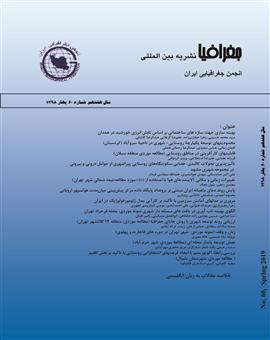محدودیتهای توسعة یکپارچة روستایی- شهری ناحیة سروآباد (کردستان)
محورهای موضوعی :لقمان زمانی 1 , عباس سعیدی 2 , عبدالرضا رحمانی فضلی 3
1 - دانشگاه شهید بهشتی
2 - دانشگاه شهید بهشتی
3 - دانشگاه شهید بهشتی
کلید واژه: محدودیتهای توسعه, توسعه یکپارچه روستایی- شهری, نظام فضایی, ناحیه سروآباد,
چکیده مقاله :
توسعه یکپارچه به مفهوم یکجانگری به ارتباط منطقی فضایی- زمانی بین بخشها در برنامهریزیهای محیطی، اقتصادی، اجتماعی و کالبدی است که قاعدتا بر مشارکت فعال مردمی و مدیریت واحد ناحیهای تاکید میورزد. افزون بر این، توجه لازم به تعامل اثرگذار عرصه هاي روستايي و شهري در این چارچوب پیوسته مورد تاکید است، زیرا در غیر این صورت، آنچه اتفاق افتد، نه به نفع مراكز روستايي و نه ياور كانونهاي شهري خواهد بود. نظام فضایی ناحیه سروآباد، با وجود قابلیت های برجسته، به دلیل فقدان ناهماهنگی ساختاری- کارکردی اقتصادی و برنامه ریزی مناسب و یکجانگر، از اهداف توسعة مطلوب و یکپارچة روستایی- شهری دور مانده است. مقاله حاضر در ارتباط با ناحیة سروآباد (شامل دو شهر سروآباد و اورامانتخت و روستاهای ناحیه) با توجه به رویکرد توسعة یکپارچه روستایی- شهری و با تکیه بر مطالعات میدانی و پیمایشی، بر اساس پژوهشی همهجانبه، به دنبال شناخت و تحلیل محدودیتهای توسعة روستایی- شهری این ناحیه بوده است. نتایج حاصله نشان میدهد، گرچه بین شاخصهای اجتماعی- فرهنگی و کالبدی- فضایی، ارتباط مستقیم و معناداری ملاحظه میشود، متغییرهای ایمنی، اقتصادی- تولیدی و طبیعی- اکولوژیک، بترتیب از کمترین ارتباط و متغییر جریانهای فضایی با نشانههای توسعة یکپارچه، از ارتباطی متوسط برخوردار است؛ در نتیجه، توسعة یکپارچه روستایی- شهری، آنطور که انتظار میرود، تحقق نیافته است.
Integrated development, in the sense of comprehensive approach to the logical integrity of spatial-temporal connections between sectors in environmental, economic, social, and physical planning procedures, emphasizes in fect, on the active participation of the people and unified management of areas. In addition, it focuses on the effective interaction between rural and urban areas, as otherwise it would be neither in favor of rural centers nor supporting urban centers. So, despite its outstanding capabilities, the Sarwabad’s spatial system was unable to achieve the goals of a desirable and integrated rural-urban development, lacking unified structural-functional planning. This article deals with the Sarwabad Area (including two cities of Sarwabad and Oraman-Takht and villages of the area). With regard to the integrated approach to rural-urban development, based on a comprehensive empirical field research, the paper has pursued the analysis and definition of the constraints of rural-urban development. The results show that, although there is a direct and significant relation between socio-cultural and physical-spatial indices, the security, economic and physical-ecological variables have the lowest correlation and the spatial flows have a medium link with the characteristics of integrated development. Therefore, As a result, integrated rural-urban development, as expected, has not been materialized.
